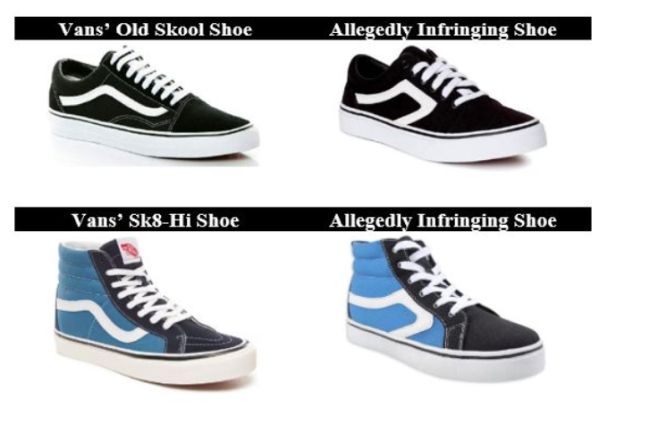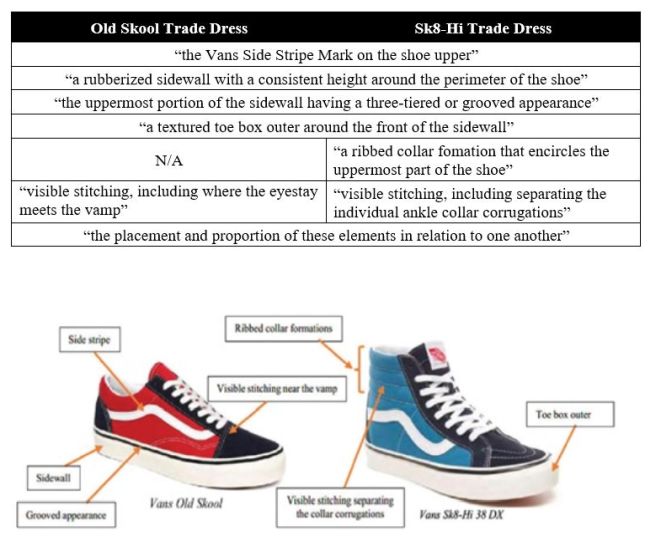Shoes come in many shapes and styles—running shoes, dress shoes, work boots, high heels, and (relevant here) skate shoes, to name a few. The designs of these shoes are virtually limitless, and if a shoe has a sufficiently distinctive and unique design, that design may qualify for trade dress protection. A distinctive shoe design can be protected as a trade dress if the design as a whole is non-functional—i.e., it is not essential to the shoe's use or purpose and does not affect the shoe's cost or quality—and the features comprising the design are clearly defined. These requirements were at the center of a Central District of California summary judgment ruling, where the Court refused to find that two of Vans' shoe designs were functional or improperly defined.
Vans is a footwear and apparel company rooted in skateboarding. Among many other products, Vans manufactures and sells shoes in its "Old Skool" and "Sk8-Hi" collections. In 2021, Vans filed a lawsuit alleging, among other things, that shoes supplied by ACI International and sold by Walmart infringe Vans' Old Skool and Sk8-Hi shoe design trade dresses:

Vans claimed its asserted trade dresses include a combination of the following features:

ACI moved for summary judgment on, among other things, two issues bearing on the validity of Vans' Old Skool and Sk8-Hi trade dresses, arguing that Vans: (1) could not prove that its trade dresses were non-functional; and (2) failed to describe the elements of its trade dresses with sufficient particularity. The Court denied ACI's motion on both points.
Regarding functionality, ACI argued that because each individual feature of Vans' trade dresses serves a utilitarian function, the trade dresses as a whole were likewise functional and thus unprotectable. While the Court agreed that each feature did serve some function—e.g., the visible stitching holds the shoe together, the side stripe supports the top part of the shoe, and the three-tiered upper sidewall ensures a consistent sole height around the shoe—the Court still found that "these minor accommodations of practical necessity" did not automatically render Vans' trade dresses functional. To the contrary, the Court found that ACI failed to show that Vans' design features, considered alone or taken together, are necessary to the design of similarly performing skate shoes. For example, ACI did not establish that the placement, shape, or prominence of the visible stitching on Vans' shoes is uniquly capable of holding a skate shoe together such that competitors would be disadvantaged if they could not copy Vans' stitching. Similarly, the Court found that, while the side stripe helps support the top of the shoe, ACI offered no evidence that Vans' specific placement is required to provide that support. As support, the Court credited testimony from Vans that "there are thousands of different shoe configurations that can still serve the function of a skate shoe," including ACI's recently launced line of skate shoes, pictured below, which the Court stated "have little in common" with Vans' trade dresses.

The Court next analyzed ACI's argument that Vans failed to describe the Old Skool and Sk8-Hi trade dresses with sufficient particularity. ACI focused its argument on Vans' descriptions of two features—"visible stitcting, including..." and "placement and proportion of [the] elements in relation to one another." ACI claimed that these descriptions were vague and indefinite because they failed to provide ACI adquate notice of the scope of Vans' infringement claims. The Court disagreed. As to the "visible stitching" feature, the Court found this term "readily definable" as "stitching that is apparent to the eye." And while the Court acknowledged that the open-ended word "including" indicated that what followed was not a complete list of the stitching Vans sought to protect, the Court concluded that a jury would have little difficulty determining that the remainder of the list contains "all other instances of stitching on the shoe that is visible." As for the "placement and proportion" feature, the Court found that this description made Vans' trade dresses more definite, as it informed ACI that a shoe only infringes if it comprises similar elements arranged in a similar manner to Vans' shoes.
Having disposed of these primary issues, the Court then addressed the remaining issues in ACI's motion. The Court rejected ACI's argument that Vans should be estopped from asserting its trade dresses due to Vans' disclaimer in a prior trademark application of one of the trade dress features asserted in this lawsuit because the Lanham Act permits an applicant to seek trademark protection in a lawsuit over matter explicitly disclaimed in an application. The Court then found that factual disputes prevented summary judgment on Vans' unfair compeition claims. Finally, the Court granted ACI's motion for summary judgment on Vans' claims under 15 U.S.C. § 1114 because that section of the Lanham Act only permits relief arising from infringement of registered trademarks, and Vans had no registrations for its asserted trade dresses.
The case is Vans Inc. v. ACI Int'l, 8:21-CV-01876 (C.D. Cal. Oct. 11, 2023).
The content of this article is intended to provide a general guide to the subject matter. Specialist advice should be sought about your specific circumstances.


